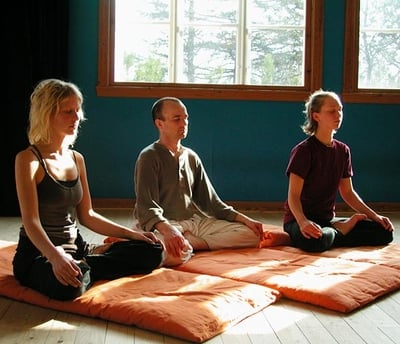Five Minute Meditations

While it is true that a single individual may never hope to bring about total world peace, we are capable of giving ourselves a break from some of the toils and turmoil that trouble us day in and day out.
Oh, but I don't have time to relax!
Wrong, dear friend.
You should always have five minutes to spare for some brief meditations. The following exercises are ones you can do anytime, anyplace, and most anywhere. Don't worry, chanting is usually optional.
What is Meditation?
Simply put, meditation is giving your mind and body a rest while remaining semi-alert of your surroundings. The goal of meditation is to let go of your thoughts for a moment, in order to put yourself at ease and make you aware of how you are feeling. When you are feeling stressed, forging ahead could lead to hurried, disastrous results. By giving yourself a moment of peace, you'll feel much better about returning to the tasks at hand.
Why Meditate?
Research shows that meditation produces many healthy benefits in the areas of body, emotional awareness, mental functioning, and relationships:
- Greater Orderliness of Brain Functioning
- Improved Ability to Focus
- Improved Perception and Memory
- Reversal of Aging Process
- Increased Self-Actualization
- Decreased Cigarette, Alcohol, and Drug Abuse
- Increased Productivity and Relations at Work
- Improved Health and More Positive Health Habits
Moreover, the Mind Body Medical Institute at Harvard Medical School provides the follow statistics:
- Chronic pain patients reduce their physician visits by 36%. (The Clinical Journal of Pain, Volume 2, pages 305-310, 1991)
- 80% of hypertensive patients have lowered blood pressure and decreased medications - 16% are able to discontinue all of their medications. (Journal of Cardiopulmonary Rehabilitation, Volume 9, pages 316-324, 1989)
- Open heart surgery patients have fewer post-operative complications. (Behavioral Medicine, Volume 5, pages 111-117, 1989)
- 100% of insomnia patients reported improved sleep and 91% either eliminated or reduced sleeping medication use. (The American Journal of Medicine, Volume 100, pages 212-216, 1996)
- Women with severe PMS have a 57% reduction in physical and psychological symptoms. (Obstetrics and Gynecology, Volume 75, pages 649-655, April, 1990)
- High school students exposed to a relaxation response-based curriculum had significantly increased their self-esteem. (The Journal of Research and Development in Education, Volume 27, pages 226-231, 1994 )
First things First
1.) Remove as many distractions as possible. Close the door; unplug the phone, the fax machine, your iPod charger, your Blackberry, your Sidekick, and your e-mail (I know it's hard, but I believe in you). Also, be sure you have nothing in the oven, the microwave, or on the barbeque. Finally, if possible, send the pets and children outside, or turn the TV on in another room, or hand them a book to read (perhaps one that will put them to sleep like David Copperfield).
2.) Some people find that music is helpful. Classical and other instrumental types of music have melodies that your mind can effortlessly follow. This may help you feel more at peace; music soothes the savage beast, and all that...
3.) Sit in a comfortable, upright posture. Place both feet on the floor, hands on your lap or legs, chin slightly bent and tummy out. As you first sit, notice any tension and try to relieve it by stretching a little beforehand.
4.) Take three deep cleansing breaths, deeply and slowly, and as you exhale, let your body relax. Breathing correctly will help you focus on yourself, as well as make you aware of the natural rhythm of your body.
5.) Concentrate on the sensation of the aware entering and leaving your body, whether it is through your nose or mouth. Notice the way your abdomen rises (inhale) and falls (exhale). With each breath, let more of the tension in your muscles melt away. After 10 or so deep breaths, slowly open your eyes.
The Dream Getaway
This little meditation uses visualization and sensory manipulation to generate feelings of contentment while relaxing your body.
1.) Get comfortable; if you like, feel free to stretch out on the floor.
2.) Start taking a few deep breathes; eventually, you'll feel yourself slip into a natural rhythm.
3.) Listen: Listen to the silence surrounding you, to the sound of your breathing. Focus now on the sounds you create within your mind. Is that music from some nearby Parisian café? Or is it merely the cry of seagulls gliding above the crashing waves?
4.) Smell and Taste: Breathe in the aromas around you. Imagine the sweet scent of fresh baguettes, or the salty tang of the sea air. Inhale deeply, and taste these gentle flavors upon your tongue as you exhale.
5.) Touch: Left your fingertips brush against the crushed velvet of your luxurious winter cloak, or feel the sand slip from your relaxed grasp. Savor the warmth of a summer day or a blazing hearth. Feel the light caress of an April shower as it taps against the top of your umbrella.
6.) See: Envision the vivid world that surrounds you like a friendly embrace. Allow the bright colors to dance beneath your eyelids, as you picture yourself walking along the street with a charming stranger, or dearly beloved.
7.) Relax for another minute, slowly drawing yourself back from this vacation until you open your eyes and return to your home/office/bus stop.
Mini-Meditations
- The Foot Focus: Concentrate on your toes. Notice if your shoes are too tight. If so, take them off. Wiggle your toes, and pay attention to how free they feel out of the shoes and in the open air. Never mind any musty aroma. If necessary, remove your socks and gently massage your toes, rubbing each one individually before moving to the ball, the arch, and the heel of your foot. Slip your shoes on again, but hold off on lacing them back up or wiggling in your ankles until absolutely necessary.
- Nose Goes: Breathe in very deeply. Attempt to isolate every pleasant smell you encounter, identify, and then move on the next one. Repeat.
- Lullaby: Very softly, sing to yourself while rocking back and forth.
It Takes Two
Here is a wonderful variation on the breathing exercise that you can do with a partner:
- Sitting, facing each other, do the breathing meditation by paying attention to your partner's breathing. If your mind wanders, that's OK, just bring your attention back to the exercise.
- Both of you lie down, facing the same direction, one partner snuggled up behind the other, like two spoons. Decide ahead of time how long you will do the meditation. Then, simply notice the breath as it comes and goes, the movement of your bodies, the sounds, and the feel of the breath on your skin.
How to Switch Off:
When you begin meditation, you're bound to have thoughts. They may be pleasant, horrifying, arousing, angry, sweet, and all will be very, very distracting. Don't worry, the mind is like a teenager, always wanting to rebel; don't worry, it's normal. Simply label each thought that passes through your head as "thinking," then go back to concentrating on your breathing. Just let the thought pass and focus on your breathing once more. The longer you practice, the quicker you will find this silence, this inner peace.
If you must make noise to assist your meditation efforts, try classics like "Ohm," "Ah," "Ooo," and humming. Have fun!









